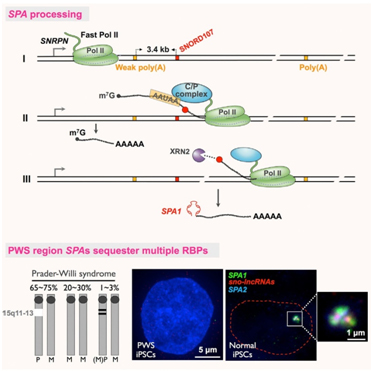Published as a full article in Molecular Cell on Oct. 27th, 2016, a research team led by Prof. CHEN Lingling, at Shanghai Institute of Biochemistry and Cell Biology, Shanghai Institutes for Biological Sciences, Chinese Academy of Sciences (CAS), in collaboration with Prof. YANG Li, at CAS-MPG Partner Institute for Computational Biology (PICB), identifieda new type of lncRNAs, elucidated their processing mechanism, and uncovered their potential implications in PWS pathogenesis.
The authors have employed a variety of techniques including RNA immunoprecipitation and deep sequencing to explore the repertoire of snoRNA related lncRNAs. These approaches allowed the authors toidentify a type of polycistronic transcript derived lncRNAs that are 5' snoRNA capped and 3' polyadenylated (SPAs). SPA processing is associated with nascent mRNA 3’ processing and kinetic competition between XRN2 trimming and Pol II elongation. Following cleavage/polyadenylation of its upstream gene, the downstream uncapped pre-SPA is trimmed by XRN2 until this exonuclease reaches the co-transcriptionally assembled snoRNP. This snoRNP complex prevents further degradation, generates a novel 5' end and allows continuous Pol II elongation. The imprinted 15q11-q13 encodes two SPAs that are deleted in Prader-Willi syndrome (PWS) patients. These PWS region SPAs, together with previously identified sno-lncRNAs (Yin et al., Mol Cell, 2012) form a nuclear accumulation that is enriched in multiple RNA binding proteins (RBPs) including TDP43, RBFOX2 and hnRNP M. Generation of a human PWS cellular model by depleting these lncRNAs results in altered patterns of RBPs binding and alternative splicing. Prader-Willi Syndrome isa multiple-system human disorder including global developmental delay, mental retardation, morbid obesity, and etc. These findings thus implicatea previously unannotated class of lncRNAs in PWS pathogenesis during early embryonic development and adulthood.
This work was supported by the National Natural Science Foundation of China and Ministry of Science and Technology of China.
CONTACT:
CHEN Lingling
Shanghai Institute of Biochemistry and Cell Biology, Shanghai Institutes for Biological Sciences, Chinese Academy of Sciences, Shanghai, China
Email: linglingchen@sibcb.ac.cn
Tel: +86-21-54921021

The model for SPA processing (top) and the nuclear localization of PWS region lncRNAsin iPSCs derived from a healthy adult and a PWS patient (bottom).
(Image provided by Prof. CHEN Lingling 's lab)
 Appendix:
Appendix: